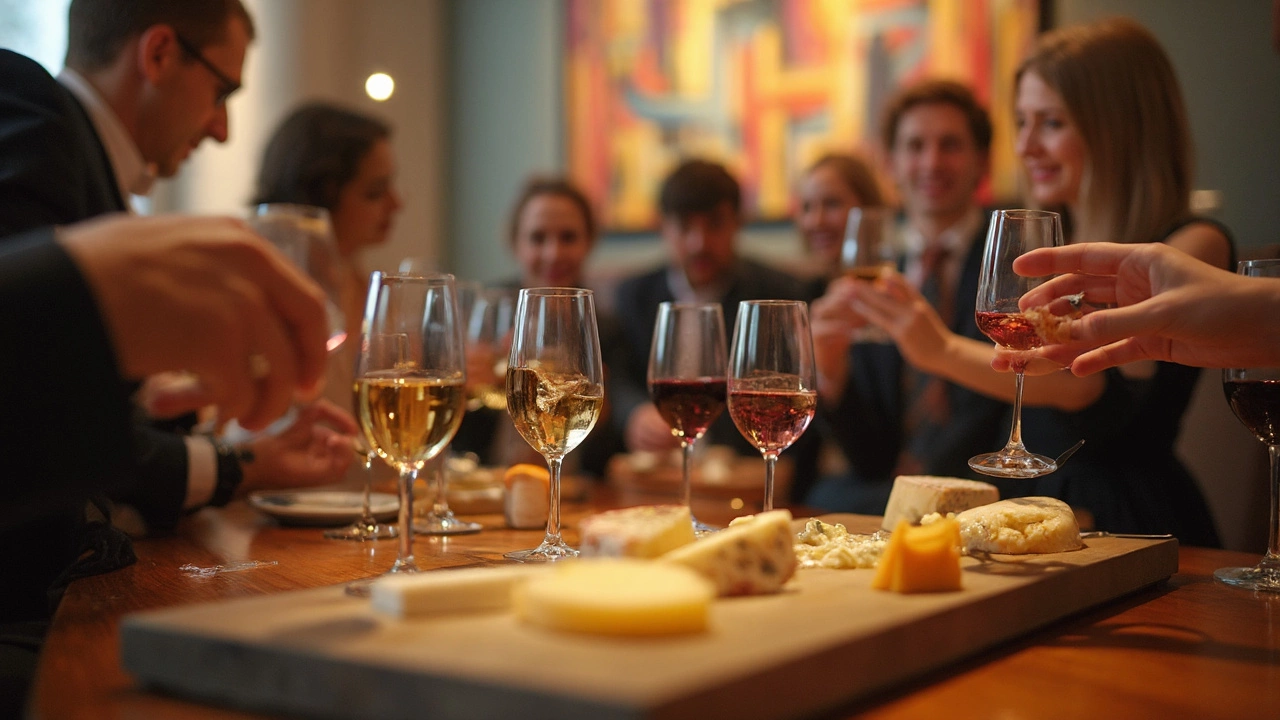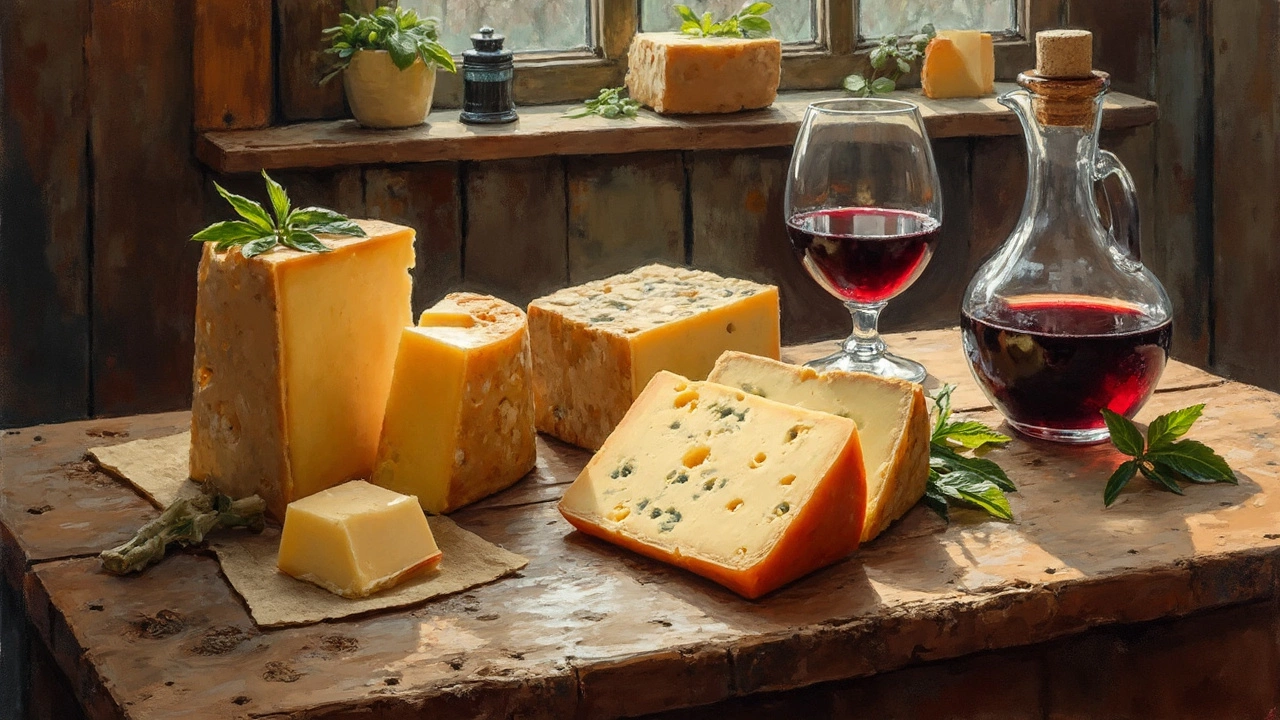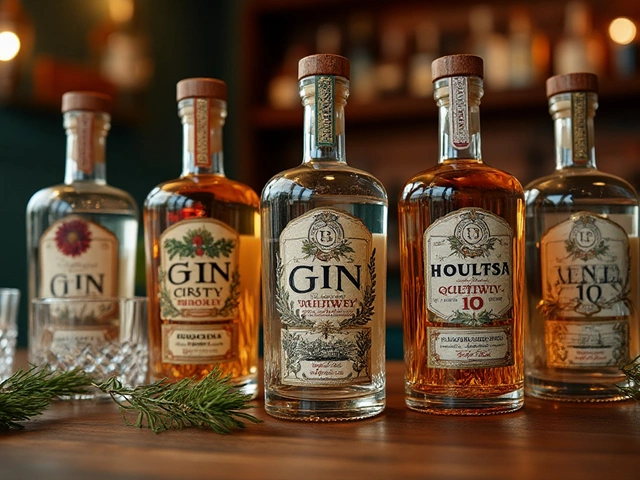Pairing wine with cheese might seem like an art, but with a little guidance, anyone can master it. If you’re holding a glass of Cabernet Sauvignon, the right cheese can enhance its rich flavors and even bring some surprises to the table. So, how do you decide which cheese to slice up next to this bold red wine?
Cabernet Sauvignon, known for its dark fruit flavors and savory notes of black pepper and bell pepper, is a match made in heaven with certain cheeses. Why? Because this wine loves robust, flavorful companions that can stand up to its intense character. Enter the world of aged and bold cheeses. Think of options like aged cheddar, which complements the wine’s complexity with its sharpness and nuttiness. If cheddar isn't your style, other aged cheeses carry similar appeal.
Of course, there’s more to explore beyond cheddar. Ever tried pairing your Cab with a slice of Gouda? This crowd-pleaser, especially when aged, becomes caramelly and nutty, a delightful counterpart to all those fruit-forward notes in the wine. Plus, it brings a creamy texture that makes every sip smooth.
- Understanding Cabernet Sauvignon
- Classic Cheese Pairings
- Tips for Perfect Pairings
- Fun Facts and FAQs
Understanding Cabernet Sauvignon
Alright, let’s talk about Cabernet Sauvignon, the world’s most popular red wine. Known for its bold flavors and full body, this wine is often described as having a rich and deep complexity. Hailing mostly from the Bordeaux region in France and California, its taste can vary depending on the region, but you’ll often find notes of dark fruits like black currant or plum.
Those robust flavors come from Cabernet’s thick-skinned grapes, meaning lots of tannins. Tannins are those compounds that give the wine an astringent feel, kind of like over-steeped tea. This quality is part of what makes Cabernet Sauvignon a great aging wine; it actually becomes more mellow and oak-influenced over time.
The Role of Climate
If you’re wondering why Cabernet from California tastes different than one from, say, France, it’s all about climate and terroir. Warmer climates like California tend to create wines with more ripe, fruit-forward flavors. Meanwhile, cooler regions yield wines with a bit more acidity and subtle earthiness.
Common Traits and Characteristics
To get a quick idea of what’s in that glass, consider these typical traits of Cabernet:
- Fruit Profile: Black cherry, cassis, blackberry.
- Aromas: Cedar, tobacco, and mint are typical aromas you'll notice.
- Palette Profile: Expect a full body with high tannins and acidity.
This full-bodied wine is no shrinking violet. It packs a punch with every sip, making it perfect for pairing with equally bold foods—like your favorite cheese.
Did You Know?
Fun fact: Cabernet Sauvignon is actually a cross between Cabernet Franc and Sauvignon Blanc, created in the 17th century. It’s pretty cool that this wine can be traced back to a happy accident!
Classic Cheese Pairings
Certain cheeses pair spectacularly with Cabernet Sauvignon, each bringing something unique to the table. If you're looking to host a wine and cheese night or simply want to enjoy a relaxing evening at home, knowing which cheeses work best with your bottle of Cab is key. Here's a rundown of some classic choices.
Aged Cheddar
Aged cheddar is a superstar when it comes to Cabernet pairing. Its sharp, tangy flavor and crumbly texture offer a perfect balance to the rich tannins and dark fruit notes found in Cabernet. The way these two mingle on the palate is a symphony of complementary contrasts – it’s a pairing that never disappoints.
Gouda
If cheddar feels too predictable, reach for Gouda, specifically the aged variety. As Gouda matures, it develops caramel and nutty flavors that match beautifully with the bold fruitiness of Cabernet. Plus, Gouda's creamy texture can mellow out some of the wine's strong tannins, making each sip silky smooth.
Blue Cheese
For those with an adventurous palate, blue cheese is an exciting partner for a Cabernet. Its pungent notes and creamy texture contrast nicely with the wine’s bold flavors, creating a sensational tasting experience. Serve it with a bit of honey or dried fruit to add a sweet balance that accentuates the pairing.
Brie
Typically, Brie might not be the first choice with a powerful red, but it's worth mentioning. Similar to when you add cream to tea, brie softens the edges of this intense wine. If you prefer a mellow bite with your drink, brie can be a soothing partner in moderation.
| Cheese | Recommended Aging | Flavor Profile |
|---|---|---|
| Aged Cheddar | 12-24 months | Sharp, tangy, nutty |
| Aged Gouda | 18 months | Butterscotch, nutty, sweet |
| Blue Cheese | Varies | Pungent, creamy, savory |
| Brie | Younger is better | Mild, smooth, buttery |
While these options are fantastic starting points, don't hesitate to explore other possibilities. Each palate is different, and part of the fun is discovering new combinations that tickle your taste buds. Cheers to happy pairing!

Tips for Perfect Pairings
Pairing Cabernet Sauvignon with the right cheese can turn any gathering into an event. But how do you make sure you're getting it just right? Here are some actionable tips to make sure your wine and cheese pairing is perfect every time.
Consider the Flavor Intensity
No one wants their cheese to overpower their wine or vice versa. Match the intensity. Bold wines like Cabernet Sauvignon pair great with robust cheeses. Look for aged cheeses which typically have concentrated flavors. For instance, an aged Gouda or a powerful blue cheese like Stilton will hold its own against the Cabernet’s strong presence.
Texture Matters Too
Texture can enhance your tasting experience significantly. Think about pairing creamy cheese with firm wines like Cabernet. The wine’s tannins and the cheese’s creamy texture create a perfect balance. An aged cheddar or even a firm pecorino can give a pleasant contrast to the wine’s smooth sips.
Serving Tips and Tricks
To get the best of both worlds:
- Serve cheese at room temperature to release its full flavor. Take it out of the fridge at least 30 minutes before serving.
- Go for a cheese board with variety—hard, soft, and even a blue cheese to create an engaging tasting session.
- Pair with accompaniments like nuts and dried fruits to complement both wine and cheese flavors.
Experiment and Have Fun
Wine and cheese pairing is as much about personal preference as it is about rules. Don’t hesitate to try new combinations beyond the classics. You might discover an unexpected pairing that works perfectly for you.
| Cheese Type | Best Paired with Cabernet |
|---|---|
| Aged Cheddar | Yes |
| Gouda | Yes, especially aged |
| Brie | No, might be too mild |
| Blue Cheese | Yes |
Fun Facts and FAQs
Pairing Cabernet Sauvignon with cheese is more than just a delicious experience; it’s also rooted in science. Here’s the lowdown on some fun crossovers between chemistry and taste.
Why Blue Cheese Works with Cabernet
Ever thought about why blue cheese makes a rich, savory match with a Cabernet? The strong, earthy flavors of the cheese meld beautifully with the tannins in the wine – it's like a symphony in your mouth. The saltiness of blue cheese can balance the bold fruitiness of the wine, making every bite and sip a harmonious experience.
The Temperature Trick
Did you know serving temperatures can make or break your tasting experience? Aim to serve cheddar and gouda at room temperature to unlock all those complex flavors, while your Cabernet should be slightly below room temp, around 60-65°F. It keeps everything tasting crisp yet intense.
Cheese Plate Perfection
When putting together a cheese platter, consider including both hard and soft options. Besides cheddar and gouda, toss in some aged parmesan or even a softer brie. Each cheese will interact differently with the wine, keeping your taste buds entertained and your guests impressed.
| Cheese | Recommended Type |
|---|---|
| Aged Cheddar | Sharp |
| Gouda | Aged (18+ months) |
| Blue Cheese | Roquefort |
FAQs
What's the best cheese for a beginner to start with?
If you're new to wine and cheese pairings, aged cheddar is a safe bet. It's widely available, has a familiar taste, and pairs easily with Cabernet.
Is it okay to chill Cabernet?
While Cabernet Sauvignon is best enjoyed slightly below room temperature, chilling it too much can dull its complex flavors. Stick to the recommended 60-65°F range for optimal taste.
Can I use flavored cheese?
Normally, it's best to stick to traditional cheeses. Flavored cheeses can complicate the pairing and might overshadow the wine's profile. Stick to pure, aged forms for the best experience.


